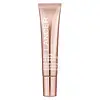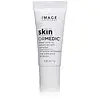What's inside
What's inside
 Key Ingredients
Key Ingredients

 Benefits
Benefits

 Concerns
Concerns

 Ingredients Side-by-side
Ingredients Side-by-side

Polyisobutene
Pentaerythrityl Tetraisostearate
EmollientIsoeicosane
EmollientIsododecane
EmollientCaprylic/Capric Triglyceride
MaskingCroton Lechleri Resin Extract
Skin ConditioningDictyopteris Membranacea Extract
AntioxidantZanthoxylum Bungeanum Pericarp Extract
Skin ConditioningButyrospermum Parkii Butter
Skin ConditioningWater
Skin ConditioningPalmitoyl Oligopeptide
CleansingTribehenin
EmollientHexylene Glycol
EmulsifyingDipotassium Glycyrrhizate
HumectantHydroxymethoxyphenyl Propylmethylmethoxybenzofuran
Skin ConditioningSodium Hyaluronate
HumectantEthylhexyl Palmitate
EmollientSorbitan Isostearate
EmulsifyingPropanediol
SolventSilica Dimethyl Silylate
EmollientButylene Glycol
HumectantEthylhexylglycerin
Skin ConditioningCaprylyl Glycol
EmollientPhenoxyethanol
PreservativePolyisobutene, Pentaerythrityl Tetraisostearate, Isoeicosane, Isododecane, Caprylic/Capric Triglyceride, Croton Lechleri Resin Extract, Dictyopteris Membranacea Extract, Zanthoxylum Bungeanum Pericarp Extract, Butyrospermum Parkii Butter, Water, Palmitoyl Oligopeptide, Tribehenin, Hexylene Glycol, Dipotassium Glycyrrhizate, Hydroxymethoxyphenyl Propylmethylmethoxybenzofuran, Sodium Hyaluronate, Ethylhexyl Palmitate, Sorbitan Isostearate, Propanediol, Silica Dimethyl Silylate, Butylene Glycol, Ethylhexylglycerin, Caprylyl Glycol, Phenoxyethanol
Hydrogenated Polyisobutene
EmollientEthylene/Propylene/Styrene Copolymer
Persea Gratissima Oil
Skin ConditioningPhenyl Trimethicone
Skin ConditioningPentaerythrityl Tetraisostearate
EmollientEthylhexyl Palmitate
EmollientPPG-12/Smdi Copolymer
EmollientTribehenin
EmollientButylene/Ethylene/Styrene Copolymer
Diisopropyl Dimer Dilinoleate
EmollientAroma
Tocopheryl Acetate
AntioxidantMica
Cosmetic ColorantLimonene
PerfumingCI 77891
Cosmetic ColorantSilica Dimethyl Silylate
EmollientSorbitan Isostearate
EmulsifyingButylene Glycol
HumectantPentylene Glycol
Skin ConditioningSodium Chondroitin Sulfate
Skin ConditioningPentaerythrityl Tetra-Di-T-Butyl Hydroxyhydrocinnamate
AntioxidantAtelocollagen
Skin ConditioningCaesalpinia Sappan Bark Extract
Skin ConditioningTocopherol
AntioxidantLinalool
PerfumingCitral
PerfumingTin Oxide
AbrasivePalmitoyl Tripeptide-1
Skin ConditioningOryzanol
Skin ConditioningUbiquinone
AntioxidantHydrogenated Polyisobutene, Ethylene/Propylene/Styrene Copolymer, Persea Gratissima Oil, Phenyl Trimethicone, Pentaerythrityl Tetraisostearate, Ethylhexyl Palmitate, PPG-12/Smdi Copolymer, Tribehenin, Butylene/Ethylene/Styrene Copolymer, Diisopropyl Dimer Dilinoleate, Aroma, Tocopheryl Acetate, Mica, Limonene, CI 77891, Silica Dimethyl Silylate, Sorbitan Isostearate, Butylene Glycol, Pentylene Glycol, Sodium Chondroitin Sulfate, Pentaerythrityl Tetra-Di-T-Butyl Hydroxyhydrocinnamate, Atelocollagen, Caesalpinia Sappan Bark Extract, Tocopherol, Linalool, Citral, Tin Oxide, Palmitoyl Tripeptide-1, Oryzanol, Ubiquinone
 Reviews
Reviews

Alternatives
Ingredients Explained
These ingredients are found in both products.
Ingredients higher up in an ingredient list are typically present in a larger amount.
Butylene Glycol (or BG) is used within cosmetic products for a few different reasons:
Overall, Butylene Glycol is a safe and well-rounded ingredient that works well with other ingredients.
Though this ingredient works well with most skin types, some people with sensitive skin may experience a reaction such as allergic rashes, closed comedones, or itchiness.
Learn more about Butylene GlycolEthylhexyl Palmitate, also known as octyl palmitate, is created from 2-ethylhexyl alcohol and palmitic acid. It is a fatty acid ester.
The fatty acid content of Ethylhexyl Palmitate makes it an emollient. Emollients help soften and hydrate your skin by trapping moisture within.
Ethylhexyl Palmitate is also used to help improve the texture of cosmetics. It helps other ingredient dissolve in products and help disperse ingredients more evenly.
You'll likely find this ingredient in sunscreen, as it is often used to mix UV-blocking ingredients such as avobenzone and ethylhexyl triazone.
It can also help stabilize the fragrances in a product as a fragrance fixative.
Ethylhexyl Palmitate can be used to substitute mineral oil.
Due to its high fatty acid content, it may not be fungal-acne safe.
Learn more about Ethylhexyl PalmitatePentaerythrityl Tetraisostearate is derived from isostearic acid. It is an emollient and emulsifier.
The highest concentration of this ingredient is found in lipsticks.
This ingredient is minimally water soluble and may not be Malassezia folliculitis, or fungal-acne safe.
Learn more about Pentaerythrityl TetraisostearateThis silica is mainly used to thicken oils and suspend particles in oils. It is not water soluble.
According to the manufacturer, it:
The manufacturer also claims this ingredient to be useful in makeup.
In lipstick formulations, this ingredient improves color payoff, reduces pigment settling, and reduces oil bleeding. This ingredient also improves the grip of powder products such as dry shampoos.
Learn more about Silica Dimethyl SilylateSorbitan Isostearate is an emulsifer and cleaning agent. It is created from isostearic acid and sorbitol.
As an emulsifier, Sorbitan Isostearate prevents oils and water from separating.
Due to its isostearic acid base, it may not be safe for Malassezia or fungal acne.
Learn more about Sorbitan IsostearateTribehenin comes from glycerin and behenic acid.
It is used as an emollient, or moisturizer. Emollients form a thin barrier on skin to prevent moisture from escaping.
This ingredient may not be Malassezia folliculitis, or fungal-acne safe.
Learn more about Tribehenin